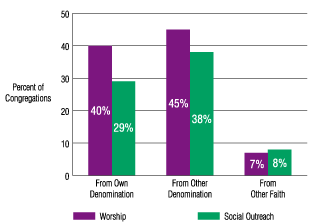A Quick Question
How common are interfaith ties among US congregations?
The quick answer: Not very common, but the numbers are sure to be growing in response to September 11th.
The longer answer: Before recent events, few of us thought to ask that question in any explicit way, so the data we have are rough estimates. In 1997-98, the Organizing Religious Work project interviewed representative of 549 congregations in 7 areas around the country. We asked extensive questions about their connections with other organizations, in their community and beyond. Among them, 10 mentioned belonging to a local interfaith coalition, and another 11 mentioned partnerships with a specific congregation from outside their faith tradition. Cities that are self-consciously diverse, like Chicago and Seattle, were the most common places to find these partnerships.
Eight of the eleven congregation-to-congregation partnerships were between Jewish and Christian congregations, one was Muslim-Christian, one Buddhist-Christian, and one Bah'ai-Christian. Whereas only about 3% of Christian congregations mentioned an inter-faith tie, one third of Jewish and other non-Christian congregations were involved. For those outside the Christian tradition, ties across faiths are more often recognized as essential. Among Christians, the practice is most common among liberal Protestants (e.g., Episcopalians, United Church of Christ, Presbyterians, plus groups such as Unitarians and Quakers).
While only this small number mentioned explicit interfaith ties, we have reason to believe that many more have at least some regular contact across faith lines - through a clergy association that is interfaith in practice, if not in name, or through joint participation in community service organization like Habitat for Humanity or soup kitchens. In metropolitan areas like Hartford and Seattle, for instance, the umbrella regional ecumenical organizations maintain active ties with Jewish, Muslim, and other groups. In short, potential lines of communication are open open, even if most Christian congregations have not routinely been using them.
In another recent Hartford Institute study, the Faith Communities Today project, the question of Interfaith involvement was asked directly. Although 45% of Christian congregations share ecumenical worship, far fewer (7%) share interfaith worship experiences. Slightly more congregations are involved in interfaith social outreach (8%).

A much more interesting pattern emerges when the Interfaith involvement is examined by religious groupings. The other category includes Jewish, Muslim, and Bahá'í religious communities.
Interfaith Involvement by Denominational Family
| |
Liberal
Protestant |
Moderate
Protestant |
Conservative
Protestant |
Catholic &
Orthodox |
Other |
| Worship |
12.3% |
8.0% |
4.0% |
13.5% |
7.3% |
Social
Outreach |
11.3% |
7.9% |
4.1% |
21.3% |
14.5% |
Overall, these data do not show a large amount of interfaith interaction between congregations taking place, but that is bound to change in the coming months as all the diverse faithful persons and communities seek each other out to come to terms with the recent events.
Return to the Quick Question archive
|
